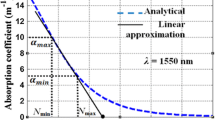Abstract
A time domain model of bulk InGaAs/InP uni-traveling carrier photodiode is developed in terms of coupled differential equations of incident photon flux and photo generated carrier density rates. For fast computation of model parameters linear approximation of material absorption coefficient is made with carrier density. Wavelength and bias voltage dependent responsivity is well demonstrated by the model and their values at different absorption layer widths agree well with the experimental results. Optical power induced output photocurrent saturation is also explained. Furthermore, from the temporal variation of output photocurrent, estimation of device bandwidth is shown.




Similar content being viewed by others
References
Adachi, S.: Properties of Semiconductor Alloys Group-IV, III-V and II-VI Semiconductors, pp. 378–379. Wiley, UK (2009)
Chtioui, M., Enard, A., Carpentier, D., Bernard, S., Rousseau, B., Lelarge, F., Pommereau, F., Achouche, M.: High-power high-linearity uni-traveling-carrier photodiodes for analog photonic links. IEEE Photon. Tech. Lett. 20(3), 202–204 (2008a)
Chtioui, M., Enard, A., Carpentier, D., Bernard, S., Rousseau, B., Lelarge, F., Pommereau, F., Achouche, M.: High-performance uni-traveling-carrier photodiodes with a new collector design. IEEE Photon. Tech. Lett. 20(13), 1163–1165 (2008b)
Coleman, P.D., Eden, R.C., Weaver, J.N.: Mixing and detection of coherent light in a bulk photoconductor. IEEE Trans. Electron. Devices 11(11), 488–497 (1964)
Connelly, M.J.: Semiconductor Optical Amplifiers, pp. 45–71. Kluwer Academic, Boston (2002)
Fawcett, W., Herbert, D.C.: High-field transport in gallium arsenide and indium phosphide. J. Phys. C Solid State Phys. 7, 1641–1654 (1974)
Guegos, G. (ed.): Photonic Devices for Telecommunications: How to Model and Measure, pp. 171–172. Springer, New York (1998)
Ishibashi, T., Furuta, T., Fushimi, H., Kodama, S., Ito, H., Nagatsuma, T., Shimizu, N., Miyamoto, Y.: InP/InGaAs uni-traveling-carrier photodiodes. IEICE Trans. Electron. E83-C(6), 938–949 (2000)
Ishibashi, T., Furuta, T., Fushimi, H., Ito, H.: Photoresponse characteristicsof uni-traveling-carrier photodiodes. Proc. SPIE, Phys. Simul. Optoelectron. Devices IX, San Jose 4283, 469–479 (2001)
Ito, H., Furuta, T., Kodama, S., Ishibashi, T.: Zero-bias high-speed and high-output voltage operation of cascade-twin uni-traveling-carrier photodiode. IEEE Electron. Lett. 36(24), 2034–2036 (2003)
Ito, H., Kodama, S., Muramoto, Y., Furuta, T., Nagatsuma, T., Ishibashi, T.: High-speed and high-output InP–InGaAs uni-traveling carrier photodiodes. IEEE J. Sel. Top. Quantum Electronics 10(4), 709–727 (2004)
Khanra, S., Das Barman, A.: Circuit model of UTC-PD with high power and enhanced bandwidth technique. Opt. Quantum Electron. 47(6), 1397–1405 (2014)
Rees, H.D., Gray, K.W.: Indium phosphide: a semiconductor for microwave devices. Solid-State Electron. Devices 1(1), 1–8 (1976)
Shimizu, N., Miyamoto, Y., Hirano, A., Sato, K., Ishibashi, T.: RF saturation mechanism of InP/lnGaAs unitravelling-carrier photodiode. Electron. Lett. 36(8), 750–751 (2000)
Acknowledgments
The work is undertaken as part of Information Technology Research Academy (ITRA), Media Lab Asia project entitled “Mobile Broadband Service Support over Cognitive Radio Networks”. Author would like to thank the anonymous reviewer for his suggestions to improve the manuscript.
Author information
Authors and Affiliations
Corresponding author
Additional information
This article is part of the Topical Collection on Numerical Simulation of Optoelectronic Devices, NUSOD’ 15.
Guest edited by Julien Javaloyes, Weida Hu, Slawek Sujecki and Yuh-Renn Wu.
Appendix 1
Appendix 1
Integrating both side of Eq. (1), we get
and employing the material loss coefficient expression of β(N) from Eq. (2) and linearised approximation of absorption coefficient α(N, λ) from Eq. (4), the above expression can be solved as
Now integrating the first term of Eq. (6) with respect to x from 0 to W A , we get
by using Eq. (7).
Rights and permissions
About this article
Cite this article
Khanra, S., Das Barman, A. Photoresponse characteristics from computationally efficient dynamic model of uni-traveling carrier photodiode. Opt Quant Electron 48, 129 (2016). https://doi.org/10.1007/s11082-015-0368-y
Received:
Accepted:
Published:
DOI: https://doi.org/10.1007/s11082-015-0368-y




